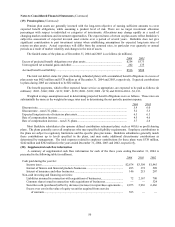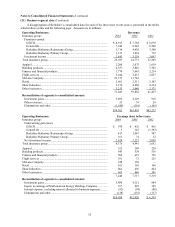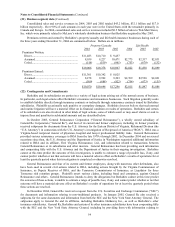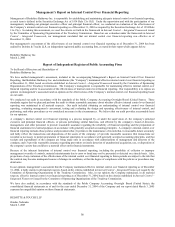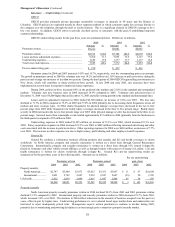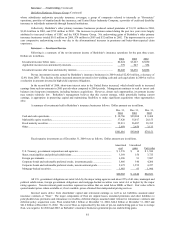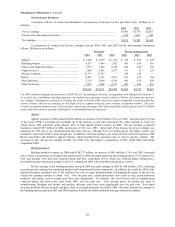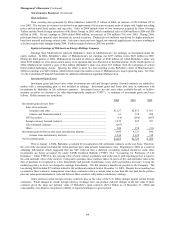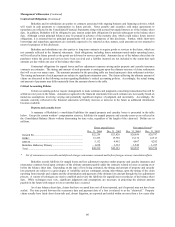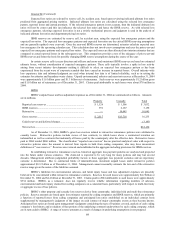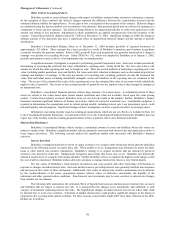Berkshire Hathaway 2004 Annual Report Download - page 61
Download and view the complete annual report
Please find page 61 of the 2004 Berkshire Hathaway annual report below. You can navigate through the pages in the report by either clicking on the pages listed below, or by using the keyword search tool below to find specific information within the annual report.
60
Management’s Discussion (Continued)
Insurance — Underwriting (Continued)
Berkshire Hathaway Reinsurance Group
The Berkshire Hathaway Reinsurance Group (“BHRG”) underwrites excess-of-loss reinsurance and quota-share
coverages for insurers and reinsurers around the world. BHRG’ s business includes catastrophe excess-of-loss reinsurance,
excess direct and facultative reinsurance for large or otherwise unusual discrete property risks referred to as individual risk.
Retroactive reinsurance policies provide indemnification of losses and loss adjustment expenses with respect to past loss events.
Other multi-line reinsurance refers to other contracts that are written on both a quota-share and excess basis, and include
participations in and contracts with Lloyd’ s syndicates. Amounts in the table below are in millions.
Premiums earned Pre-tax underwriting gain (loss)
2004 2003 2002 2004 2003 2002
Catastrophe and individual risk...................................... $1,462 $1,330 $1,283 $ 385 $1,108 $1,006
Retroactive reinsurance .................................................. 188 526 407 (412) (387) (433)
Other multi-line.............................................................. 2,064 2,574 1,610 444 326 (26)
Total ............................................................................... $3,714 $4,430 $3,300 $ 417 $1,047 $ 547
Catastrophe and individual risk contracts may provide exceptionally large limits of indemnification, often several
hundred million dollars and occasionally in excess of $1 billion, and cover catastrophe risks (such as hurricanes, earthquakes or
other natural disasters) or other property risks (such as aviation and aerospace, commercial multi-peril or terrorism). Catastrophe
and individual business written totaled about $1.5 billion in 2004 and $1.2 billion in 2003. The level of business written in
future periods will vary, perhaps materially, based upon market conditions and management’ s assessment of the adequacy of
premium rates. Premiums written in 2004 included $165 million to reinstate coverages as a result of the third quarter hurricane
losses.
In 2004, underwriting results from catastrophe and individual risk business included estimated catastrophe losses of
$790 million, primarily from four hurricanes that struck the U.S. and Caribbean during the third quarter. The catastrophe and
individual risk business produced substantial underwriting gains in 2003 and 2002 due to the lack of catastrophic or otherwise
large loss events. However, catastrophic losses (such as the recent hurricane losses) are anticipated to occur over time, which
could exceed the gains earned in recent years. The pre-tax maximum probable loss from a single event at December 31, 2004 is
estimated to be $5 billion resulting from potential risk of loss from a major earthquake in California. BHRG, as a matter of
general practice, does not cede catastrophe and individual risks to other reinsurers. The timing and magnitude of such losses
may produce extraordinary volatility in periodic underwriting results. Nevertheless, Berkshire’ s management remains willing to
accept such volatility provided there is a reasonable prospect of long-term underwriting profitability.
Retroactive reinsurance contracts indemnify ceding companies for losses arising under insurance or reinsurance
contracts written in the past, often many years ago. While contract terms vary, losses under the contracts are subject to a very
large aggregate dollar limit, occasionally exceeding $1 billion under a single contract. Generally, it is also anticipated, although
not assured, that claims under retroactive contracts will be paid over long time periods. These contracts do not produce an
immediate underwriting loss for financial reporting purposes. The excess of the estimated ultimate claims payable over the
premiums received is established as a deferred charge which is subsequently amortized over the expected claim settlement
periods. Such amortization is included as a component of losses incurred.
Underwriting losses from retroactive reinsurance are primarily attributed to the amortization of deferred charges
established on retroactive reinsurance contracts. Deferred charges, which represent the difference between the policy premium
and the estimated ultimate claim reserves, are amortized over the expected claim payment period using the interest method. The
timing and amount of expected future losses are re-estimated periodically. Deferred charge balances are adjusted accordingly on
a retrospective basis via a cumulative adjustment.
Gross loss reserves established under retroactive reinsurance totaled approximately $10 billion as of December 31,
2004 and losses paid during the year totaled approximately $860 million. Unamortized deferred charges at December 31, 2004
totaled approximately $2.45 billion compared to approximately $2.85 billion as of December 31, 2003. Management believes
that these charges are reasonable relative to the large amount of float generated from these policies. Income generated from the
investment of float is reflected in investment income and investment gains.
Premiums earned in 2004 from traditional multi-line reinsurance decreased $510 million (19.8%) compared to 2003.
The comparative decrease was primarily due to declines in quota-share participations (including Lloyd’ s) and the termination of
a major quota-share contract in mid-2003. Several contracts were not renewed or were curtailed in 2004 so further premium
declines are anticipated in 2005. Pre-tax underwriting results in 2004 included losses of approximately $175 million arising
from the third quarter hurricanes affecting the United States and Caribbean. However, these losses were more than offset by
increased underwriting gains in aviation coverages and approximately $160 million in gains from the commutations of several
reinsurance contracts in 2004. Underwriting gains in 2003 reflected low amounts of property and aviation losses. There were no
significant commutations in 2003.
Berkshire Hathaway Primary Group
Berkshire’ s primary insurance group consists of a wide variety of smaller insurance businesses that principally write
liability coverages for commercial accounts. These businesses include: National Indemnity Company’ s primary group operation
(“NICO Primary Group”), a writer of motor vehicle and general liability coverages; U.S. Investment Corporation (“USIC”),


